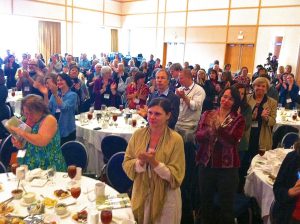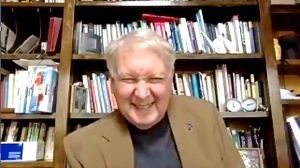Our Government is Run By Sadistic Pedophiles So They Don’t Want Any Dr.’s Researching Sexually Abused Child Victims & CIA Runs Child Sex Slave Rings (For CABAL)
Focus on ISSTD History
An Interview with Frank Putnam, Part I
An Interview between Warwick Middleton, MD and Frank Putnam, MD
Part One: The Early Years: Child Abuse Research, Dissociation and the Formation of the Society
WM: Let me start Frank by asking how you became involved in this area of dissociative disorders, complex trauma and the long-term outcome of child sexual abuse?
FP: I did my psychiatry residency at Yale University from 1976-79. That was before PTSD was officially a disorder. We had a large number of young Vietnam vets who were quite hyperactive and somewhat aggressive. I was very fortunate to be supervised by Art Blank, a Vietnam veteran himself … an army psychiatrist in Vietnam. Art really understood PTSD. So, I saw a lot of PTSD, including abreactions and flashbacks.
I didn’t really want to specialise in PTSD but Art kept sending me cases. I didn’t see PTSD as a career. I was interested in biological psychiatry – especially in the circadian rhythms of people who were bipolar and rapidly switching. After I finished my residency I did a clinical research fellowship at the National Institute for Mental Health (NIMH). I stayed on at the NIMH for 20 years.

Frank Putnam, Bethany Bjur and Warwick Middleton, Zoom interview, February 2019
At NIMH we had a ward of rapid cycling bipolar patients. They were moving back and forth – sometimes every couple of days – between episodes of mania and depression. I was seeing all of these amazing mood state transitions. What I discovered as I talked with these bipolar patients was how many of them were traumatised, especially (with) histories of childhood maltreatment. I think I was able to recognise their trauma because of my experience with Vietnam veterans.
Serendipitously, I turned up a case of DID, as we call it now, a woman who was in a wheelchair. She had a classic “hysterical paralysis” and couldn’t walk…but every once-in-a-while the nurses would find her curled up across the room from her wheelchair and talking like a little baby. In group therapy I observed dramatic switches in her and wondered – what could this be? The switches were far too rapid to be bipolar disorder. That led me to investigate the possibility that it was…Multiple Personality Disorder.
It turned out that was correct and it solved the problem … we were able to successfully discharge her from the hospital and into an outpatient treatment program. She subsequently did quite well. I thought that was amazing, but doubted that I’d ever see another case of this rare disorder. Very shortly, however, I had turned up two more. Of course, I was immediately accused of causing them!
WM: That’s a familiar pattern Frank!
FP: I’m afraid so! That first case led to my beginning to look for MPD cases systematically. I saw maybe 10 or 12 clinical cases over a short period of time and I began to do the neurophysiology studies with them. I began … looking at the personality states much like we worked with the bipolar mood states – looking at the psychophysiology of one state versus another state.
I learned that they all had histories of severe childhood maltreatment and said that they had been multiple since childhood. I thought – well if this is true, I should be able to find child multiples. So, I went looking for child cases. … We developed a profile of what a child with a dissociative disorder might look like to a teacher, social worker, counsellor. We created a child MPD profile, which later became the basis of the Child Dissociative Checklist. I took that initial profile and circulated it to child protection services in the Washington DC metro area. I asked to see any of their kids … who fit this profile. Then I saw a series of child protection-referred abused children.
At that time, I was not trained in child psychiatry. I was still an adult psychiatrist. I had a child psychologist or a child psychiatrist with me when I saw these kids. I became convinced – not only that a few of them were dissociative – but that many of the children were disturbed or abnormal in other ways. I became interested in looking at these adverse effects prospectively because it seemed so complicated to retrospectively disentangle the outcomes.
That led me to start a prospective longitudinal study with a developmental psychologist, Penelope (Penny) Trickett. Penny and I started the study with 100 sexually abused girls and 100 non-abused comparison girls aged 6 – 15 years. We had a great deal of trouble convincing the leadership at the NIH to fund us. Eventually they said: “you can do this study but we won’t pay for it, and you can’t do it on the NIH campus.” So, we had to go outside of the NIH and ask a private foundation to give us money to do a study at the NIH, which was unheard of!
We were most fortunate to have a paediatrician, Robert Haggerty, president of the W.T. Grant Foundation. Dr. Haggerty was concerned about the effects of sexual abuse on children. He gave us a grant and we rented offices off the NIH campus. We recruited our abuse subjects from child protection agencies and matched controls from social service agencies..
We started that study in 1986. It still continues today. Now we even have grandchildren of our original children enrolled in the study. We have published at least 40 or 50 papers from the study (search Penelope Trickett, Jennie Noll and/or Frank Putnam). We looked at the biology, the psychology, and the sociology of this sample from pre-puberty into adult/motherhood. It was the first study to prospectively demonstrate the powerful, life-long, pervasive effects of sexual abuse on biological development.
WM: Frank, just to put it in the context, the world literature in that area when you undertook that study was..?
FP: There was nothing, basically. (Laughs) There was a little bit on the biology of trauma through the Vietnam veterans. There was a researcher, John Mason, who had done some research looking at the parents of children with cancer. He was able to follow their emotional swings by looking at changes in stress markers such as cortisol, but that was about the sum total of the biology of trauma at that time.
We began looking at cortisol, but also several other stress markers. (We also) looked at endocrine hormones – FSH, LH and oestrogen etc. and how sexual abuse effected female pubertal development. We found that sexually abused girls went through puberty about nine months earlier than our control girls. Much of that difference was explained by their trauma histories.
WM: One of the things that you did Frank, which was remarkable, is that in furthering your credentials in the field as a researcher on child abuse that you undertook training as a child psychiatrist at that stage of your career.
FP: That was a very busy time in my life. When I look back: I got married, I had children, I went back to

Standing Ovation Frank’s ISSTD Lifetime Achievement Award, Annual Conference, Baltimore, 2013
into training doing a Fellowship in child psychiatry. I ran the prospective study pretty much by myself because
Penny had married and moved to Los Angeles. … Also, I became very ill in the middle of this with a mysterious infection that put me down for about six months with four hospitalizations. It took about two or three years to
feel normal again. It is amazing that we got as much done as we did, but I had a really, really good staff who were mostly volunteers, or graduate students – very, very dedicated. At times they worked for weeks without pay until I could score another grant.
WM: What was your evolving relationship with the NIH etc.?
FP: Well, very interesting. I was repeatedly told that I was pursuing a social problem, not a scientific problem. Basically, I could only do what I could accomplish on my own. I wasn’t given any institutional resources. So, we had to go outside of the NIH for money. We had to rent our research space off campus. But we were able to use some of the benefits of the NIH such as paying our subjects for their participation and transportation. I was left alone a fair amount of time, however, which was a good thing.
Then two things happened that I’ve never quite understood.
One was that the National Association of Social Workers prevailed upon the U.S. Congress to allocate a one-time sum of $40 million for research on child maltreatment. Congress also mandated that the NIH Director brief Congress on what NIH was doing about child maltreatment. As I was the only one at NIH who knew anything about child maltreatment, they dragged me over to the NIH Director’s office. I worked with his staff for weeks to write the Director’s remarks to Congress. I was thrilled that the NIH Director was going read my comments into the Congressional record when he testified. In reality it was just placed in Congressional record … It just part of an informational package they sent over to Congress. At one level I thought, now we are finally getting recognition. The NIH Director is paying attention. Boy, was I wrong!
The other thing was that I gave a public presentation at the NIH on our sexual abuse research. Afterward, a group of people came up to me. They told me about what sounded like a child sexual abuse ring, based on the NIH campus. It was all hearsay, but I took it to a District Attorney whom I had worked with on other cases.
Shortly thereafter, they arrested and charged a NIH Nobel Prize winner named Daniel Carleton Gajdusek, who was known for the discovery of Kuru. At the trial he clearly got a very special plea deal. He was allowed to first resign from the NIH and therefore keep his government pension. Although at least 40 children were known to be involved, he was only charged with one minor count. He served a short time in prison. On release, he was picked up at the prison gate by a limo and flown to Paris. He lived the reminder of his life in Europe as an unrepentant paedophile.

Frank Putnam, Screen shot, from interview – 19th February 2019
WM: What year was this Frank?
FP Roughly about 1995/1996. (Gajdusek was arrested in April, 1996). After that I was suddenly in big trouble. I got a terrible internal scientific review. They decided to terminate all child abuse research at NIH. I was fortunate to be able to transfer the prospective longitudinal study to my former project manager, Jennie Noll, who continues to direct it from Penn State University. But it was impossible to save all the data, records, and biological samples etc. A lot was lost.
Fortunately, I found a very good position elsewhere. In many ways it was one of the better things that happened to me career -wise, but at the time it was devastating to lose control of that work and become a persona non grata.
Now I believe that this was in retaliation for causing the arrest and conviction of a NIH Nobel Prize winner. I moved to Cincinnati Children’s Hospital in July 1999, where, as a Professor of Paediatrics, I worked on developing child abuse treatment and prevention programs.
WM: While all this was going on you were evolving an interface with Dissociative Identity Disorder, as it is now known. You published in 1989 what was then the most comprehensive text book on the diagnosis and treatment of DID or MPD. Can you lead us through how that book came to be?
FP: Well my first definition of an “expert”, is somebody who knows slightly more than the people in the audience asking questions. My more serious definition of an expert is somebody who knows what they don’t know, as well as what is not known by the field as a whole. So, although I was viewed as an expert – whether I was or not – I found myself in a situation where I was doing a lot of case consultations. I ran a study group in the evenings for therapists who were treating dissociative patients…I also was consulting with experts …
As a result of this immersion, I began to see common clinical threads and thought – the field needs a book. So, I eventually said to myself, “OK I’ll write that book .” (Putnam, FW 1989) I finished it in early ‘87 but it wasn’t published until ‘89 because of that mysterious infection which hobbled me for a couple of years. The book is a compilation of what were considered best practices at the time. I don’t claim unique ownership. I just pulled together the knowledge in the field and organized it into a book.
WM: It would be remiss of me not to ask you about the evolution of the Dissociative Experiences Scale in which you played a significant role.
FP I concluded, very early on, that we need a dissociation scale. I was presenting some of our early brain scan work to a psychology colloquium at American University. On my way out, standing by my car, was a young lady, Eve Bernstein Carlson. She said, “What you need is a dissociation scale.” … Eve was a first-year graduate student. We started working on the dissociation scale … we worked on the scale for multiple years until she was ready to defend her PhD dissertation. … I was told that I could copyright the DES, but I chose not to. I chose to aggressively support the scale, to send it out free to people. … Now it has four or five thousand citations in peer-reviewed journals.
WM: You were one of the foundation committee members that met and formed what became known as ISSTD. Can you tell us about your perspective of how that came to be?
FP: Sure. There were several us who thought there should be a dissociative disorders Society, with its own journal. There was another dissociative disorder group run by George Greaves who also believed this. At the multiple personality disorder meetings in Chicago, these two groups came together. At first the two groups were competitive, but after we all sat down for dinner at Mama Leonie’s – where we had her famous pizza – we decided that it would work better as a single Society … I’m not sure we were quite as far-sighted as it’s been made to seem retrospectively, but we did manage to get the society off the ground and the first journal, Dissociation, published.
What I am most happy about is that I was able to work with Jennifer Freyd to digitally archive Dissociation at the University of Oregon Library. So, all those old issues, which contain some seminal studies, are still available online for free.
Read more about Frank and past, present and future directions for ISSTD in Part 2.
References
Putnam, FW (1989). The Diagnosis and Treatment of Multiple Personality Disorder. Guilford Press, New York.
Category: Focus on ISSTD History
Comment: Here is How Randy Turner was “Split” to Make Him Into an Unwilling Robotic Assassin working for the CIA/Deep State Criminals.
Randy Turner’s Account of Sexual Abuse by Bill Day, Jimmy Carter and Herbert the Pervert Walker Bush when he was around the age of 13-14.
Maybe a week After I had beat Bush Jr. up during our white house tour I am laying in bed and wake up to Bill Day walking into the room.
He sat on the bed to my left and grabbed my left arm then G.H.W Bush walks in and then {Jimmy} Carter walks in and I was thinking wtf is the president doing in my bedroom?
Carter gets on the bed and grabs my right arm and I believe they shoved these long cardboard tubes on my arms which were to make sure I wasn’t able to fight back.
Bush says I heard what u did to my boy you son of a bitch! Bush reaches down and grabs my testicles and starts crushing them.
I was begging them to kill me the pain was so bad and I must have passed out from the pain.
Bill Day was saying things into my left ear as Bush was torturing me, something about not trusting cops or authority and at some point I passed out.
I recall coming to looking down and seeing poppy sucking on my penis.
Carter was saying something into my right ear as Bush was trying to stimulate me sexually; he was saying something about sex with boys, girls, young or old is all good like he was trying to convince me nothing was wrong with sex with young kids with older women and men. I don’t recall what all they programmed just the beginning of it and the rest is a blur.
This continued for what seemed like an hour or more but during one of my court trials Bush claimed I popped within 15 minutes.
When being tortured to this extreme 15 minutes can feel like and hour.
The (popping) is what happens when the brain is unable to deal with the pain it makes a physical change and when this occurs you feel and hear a popping sound in your head.
I am no expert on how it works but I do recall some medical professional explaining it during my court trial saying the brain can physically alter itself to stop pain receptors in some people.
This popping noise is that the victims hear and feel in their head.
It is at this point the Alternates are created.
These Alternates are given names and have completely different personalities from the person being programmed.
The drug they use (Adrenochrome) allows the programmer to feed information into the subconscious and when the drug wares off the victim will have no memory of what took place or a very vague memory of something but usually will relate it to a dream or nightmare they had and not reality.
Comment: Mind Control is essentially a Rothschild Zionist project and done on military bases in conjunction with the CIA primarily. The Rothschild’s consider theirselves ‘Jews’ but are the Synagogue of Satan and mind control is a Satanic project.
Fritz Springmeier has heavily researched Mind Control and his pdf books are readily available for free on the internet.
BY ADMIN · PUBLISHED JANUARY 13, 2020 · UPDATED JANUARY 31, 2020
Randy Turner
19 hrs ·
David Rockefeller had his brother Nelson assassinated via poisoning by a 13 year old MKUltra which G.H.W Bush programmed to poison him. Nelson was going to run for president and David didn’t want Nelson in because he couldn’t control him. After Bush had Nelson assassinated David went back on his promise to make George president and instead chose Reagan as President and George VP. This led to George using the 13 year old MKUltra to frame David as taking part in drugging and t…See More
Tags: ILLUMINATI CRIMINALSMind ControlMKUltraPedophilia NonprosecutionPolitical Corruption/ManipulationPOLITICIANSRape/TortureTortureViolent criminals (crimes)
https://brutalproof.net/2020/01/16-year-old-mkultra-used-for-reagan-assassination/The ReaganAssassination Attempt This is the true story of a CIA MKUltra victim who was used at the age of 16 to assassinate then President Ronald Reagan. Randal has proof to validate being used as a CIA Mind Control assassin during the attempt.Videos
 Posted in News
Posted in News  Tags: assassination, mkultra, reagan
Tags: assassination, mkultra, reagan












